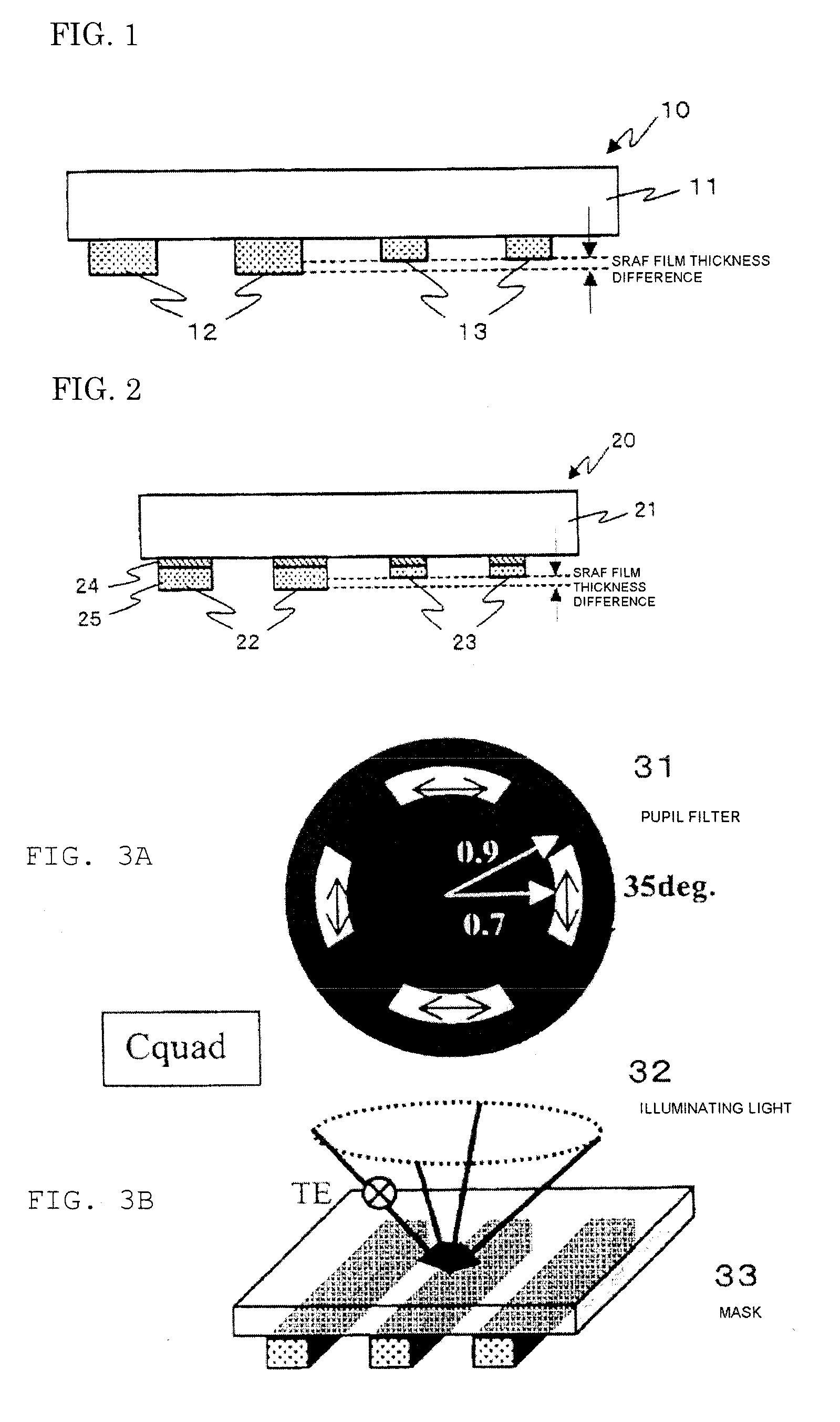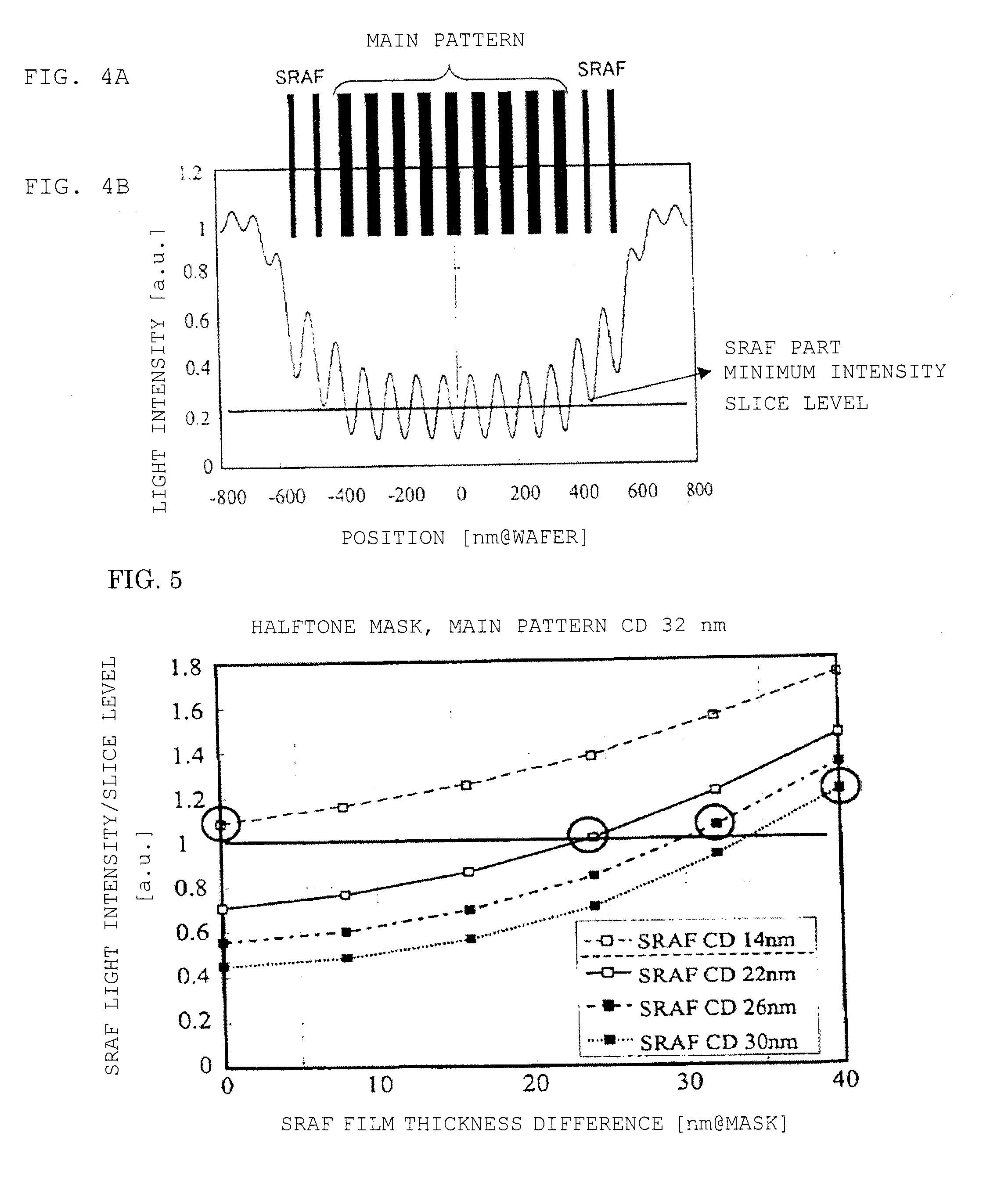Photomask and methods for manufacturing and correcting photomask
a manufacturing method and technology for masks, applied in the field of masks and photomask manufacturing methods, can solve the problems of difficulty in supplying pattern, and difficulty in mask production, so as to reduce mask costs, improve mask quality, and improve mask quality
- Summary
- Abstract
- Description
- Claims
- Application Information
AI Technical Summary
Benefits of technology
Problems solved by technology
Method used
Image
Examples
first embodiment
[0139]Thus, a manufacturing method of a photomask of the present invention is a manufacturing method for solving the above-mentioned problems, and a manufacturing method of a photomask which uses an ArF excimer laser as an exposing source, is used for a projection exposure by an off axis illumination, and is provided on a transparent substrate with a main pattern to be transferred to a transfer-target surface by a projection exposure and an assist pattern to be formed nearby the main pattern and not transferred to a transfer-target surface.
[0140]FIGS. 7A to 7E is a process cross-sectional schematic view showing a first embodiment of a manufacturing method of a photomask of the present invention shown in FIG. 1. As shown in FIG. 7A, a semi-transparent film 72 is formed on a transparent substrate 71 such as a synthetic quartz substrate to obtain film thickness for allowing a retardation of approximately 180° between the light transmitting through the semi-transparent film 72 and the l...
second embodiment
[0150]FIGS. 8A to 8E are a process cross-sectional schematic view showing a second embodiment of a manufacturing method of a photomask of the present invention shown in FIG. 1; similarly to FIG. 7A, a semi-transparent film 82 is formed on a transparent substrate 81 to obtain film thickness for allowing a retardation of approximately 180° between the light transmitting through the semi-transparent film 82 and the light transmitting through a transparent region of the transparent substrate 81, and subsequently prepare photomask blanks such that a light shielding film 83 is formed on the above-mentioned semi-transparent film (FIG. 8A).
[0151]Next, a first resist pattern 84 is formed on the light shielding film 83, and the light shielding film 83 and the semi-transparent film 82 are sequentially dry-etched to stop etching in the halfway stage of half-etching the semi-transparent film 82. In this stage, a thin layer of the semi-transparent film 82 to be removed remains partially on the tr...
third embodiment
[0156]FIGS. 9A to 9F are a process cross-sectional schematic view showing an embodiment of a manufacturing method of a photomask of the present invention shown in FIG. 2. As shown in FIG. 9A, a semi-transparent film 92a and a semi-transparent film 92 are sequentially formed on a transparent substrate 91 such as a synthetic quartz substrate to form a two-layer semi-transparent film. The lower-layer semi-transparent film 92a has the function of an etch stop layer during dry-etching of the upper-layer semi-transparent film 92 and also has the function as a mask material for a semi-transparent film. The film thickness for allowing a retardation of approximately 180° between the light transmitting through the two-layer semi-transparent film and the light transmitting through a transparent region of the transparent substrate 91 is obtained to subsequently prepare photomask blanks such that a light shielding film 93 is formed on the above-mentioned two-layer semi-transparent film.
[0157]A c...
PUM
 Login to View More
Login to View More Abstract
Description
Claims
Application Information
 Login to View More
Login to View More - R&D
- Intellectual Property
- Life Sciences
- Materials
- Tech Scout
- Unparalleled Data Quality
- Higher Quality Content
- 60% Fewer Hallucinations
Browse by: Latest US Patents, China's latest patents, Technical Efficacy Thesaurus, Application Domain, Technology Topic, Popular Technical Reports.
© 2025 PatSnap. All rights reserved.Legal|Privacy policy|Modern Slavery Act Transparency Statement|Sitemap|About US| Contact US: help@patsnap.com



